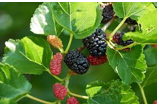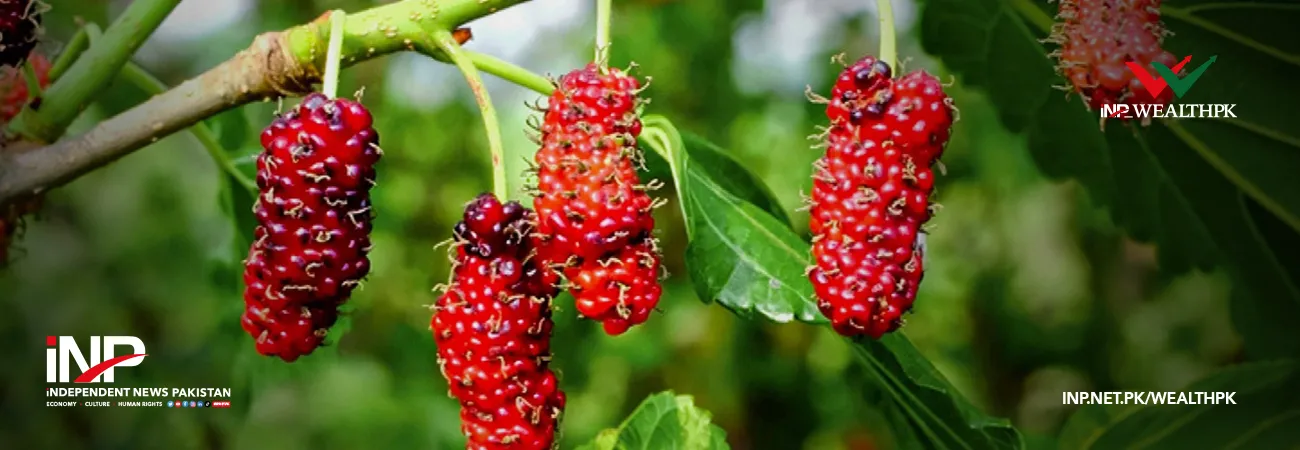INP-WealthPk
Faiza Tehseen
Given its numerous economic benefits, mulberry cultivation should be expanded across Pakistan.

“Extensive plantation of mulberry can be carried out on marginal lands for ecological protection, mitigating climatic impacts and getting fodder for livestock,” said Dr Riffat Tahira, programme leader of the National Medicinal, Aromatic, and Herbs Programme of Pakistan Agricultural Research Council (PARC). Discussing the nutraceutical value of mulberry with WealthPK, she said: “It is listed as the third-generation fruit and superfood. All parts of mulberry, including its seed oil, are useful in many aspects.
Mulberry fruit delays aging, prevents premature white hair and obesity effects.” She said that different parts of mulberry are used to produce medicines, cosmetics, culinary items, beverages, air-fresheners, candles, soaps, tarts, and tea. “Under cold storage, pure mulberry juice can last at least three months without adding preservatives. A special edible carbon is made by the carbonisation of mulberry root and stem. It is widely used as food additive.” “Mulberry is low in calorie and can be consumed fresh or dried.
A demanding cottage industry can be established to make products from different parts of mulberry plant, including fruit. Value-added products of mulberry can fetch financial benefits for farmers,” Tahira said. Sharing the eco-economic value of mulberry, Muhammad Akbar, an environmental scientist from Gilgit-Baltistan, said: “The dense canopy and broad leaves of mulberry stabilise microclimate – reducing wind speed and temperature, and increasing air humidity.
Mulberry has potential for carbon sequestration and can help mitigate global warming effects.” He said that one hectare of mulberry plantation absorbs about 63 tonnes carbon dioxide (equivalent to 17.2 tonnes of carbon) and releases about 46 tonnes of oxygen yearly. “Likewise, one cubic meter mulberry plantation can absorb about 20ml sulphur dioxide per day. Mulberry is highly resistant to chlorine pollution as well. The absorption of carbon dioxide, sulphur dioxide, and resistance against chlorine makes mulberry an ecological tree species.” Akbar said that mulberry is a highly stress-tolerant species.
“A strong tangled root network of mulberry stabilises soil, decreases dispersion rate, soil erosion, conserves water, and increases water stability index when planted on sloped land. As compared to other forest species, it increases aggregation degree and status of topsoil by about 25% and 50%, respectively. It is useful for saline land management and desertification control.” He said mulberry was stress-tolerant and could be grown in water-scarce regions like Gilgit-Baltistan.
Meanwhile, talking to WealthPK about the importance of mulberry leaf and tender shoots for animal feed, Mahar Sikander Hayat, Senior Scientist (Fodder) at the Fodder Research Institute, Sargodha, said, “One acre of mulberry produces about 0.67 tonnes of proteins that is equivalent to protein contents of 1.20 tonnes soybean. Essential components in it develop immunity against diseases in livestock and poultry.” He said that mulberry forage is highly palatable and its digestion rate in livestock is 70%-80%. “It improves the milk and body weight of animals.”
Hayat said: “On an average, mulberry plantation over an acre produces about five tonnes of dry mulberry leaves, rich with essential nutrients. Each 100 grams dry mulberry leaves contain about 2.7 grams of calcium and 3.1 grams potassium, greater than the calcium content in the same mass of red shrimp or fish powder.” He said: “Mulberry is less adopted in the areas where traditional fodders can be grown in abundance. As for a mixed ration for livestock, especially in areas like Khyber Pakhtunkhwa, mulberry is beneficial where main fodder crops can’t be grown.”
Meanwhile, talking to WealthPK about the importance of mulberry plantation, Muhammad Aatif Majeed, Deputy Director (Technical) at the Pakistan Forest Institute, Peshawar, said: “Mulberry grows faster, and its wood is fine, close grained, heavy, tough, and moderately durable. It is used to manufacture a variety of wooden products, including sports goods, furniture, architectural building models, house building, shuttering, wall panelling, plywood, carvings, spokes, poles, turnery, veneer, recombined wood boards, floor boards, door jambs, toys, casts, carriage shafts, boats, and paper.”
He said the stem and branches of mulberry can be used as mushroom growing medium. “The ratio between carbon and nitrogen is 86:1, which is suitable for culturing mushrooms. The stem powder of mulberry is used for producing a variety of mushrooms. Silkworms are also grown on leaves. The multifarious economic uses of mulberry warrant its large-scale plantation under different horticulture and forestry programmes.” It is dried for both commercial and domestic purposes in the areas of Astore, Chitral, Gilgit, Hunza, Shigar, and Skardu, etc”.
Credit: INP-WealthPk




